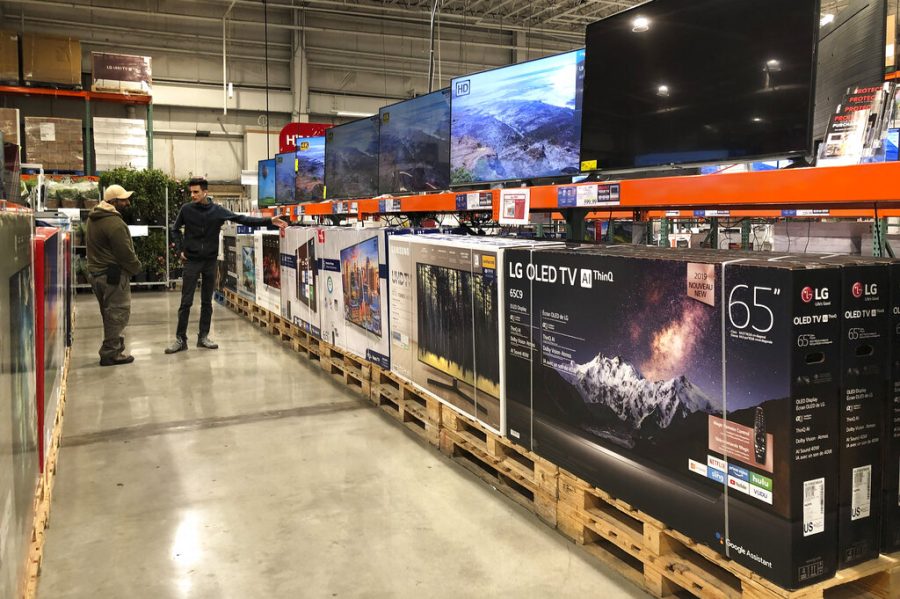Smart TVs: Futuristic or Forced?
Two men compare television brands LG, Samsung, TCL, Sony and Vizio, while shopping at a retail store, Monday, May 13, 2019, in New Rochelle, N.Y. (AP Photo/Julie Jacobson)
I like my old TV. No, I really do. I currently own an old Vizio flat-screen from 2007. It’s not 4K, it’s not smart, and it doesn’t have Bluetooth. But I wouldn’t have it any other way.
The issue is its age. It’s beginning to show it with digital artifacts on the screen. I’ve come to terms with the fact that, at some point, I’ll need a new one. I could fix this one, but that would be far too expensive to warrant. I will miss the actually decent speakers that manufacturers included back in that era, the simple menus, the port selection. It’s a good TV, simply put.
Another issue is finding a new one. I’ll search on Amazon, Best Buy, Target, and find myself disappointed in the results I find. I’m ready to make the move up to 4K. It’s a move to futureproof, I tell myself. Speakers built-in to TVs these days are terrible, but I have a separate sound system to make up for it. The main issue that I have with the majority of displays that are recommended to me is a feature that many are eager to use, but for me, is a deal-breaker. Smart TV technology.
See, we have a smart TV in the living room. Another Vizio, about 10 years older than my “dumb” TV. It has a good display on it, terrible speakers (again, par for the course). The issue is, of course, its smart integration. It began okay, but around a year after we bought it, its Wifi completely died. That was fine, we thought, as we could simply plug an Apple TV or Fire TV stick into it to replace the features lost.
However, its unused software began causing problems. In the middle of playing content, the TV would randomly reboot. We clearly weren’t using any of the Smart TV’s software at the time, but something in its code was causing it to reboot. Vizio said it was a software issue, and we tried everything to fix any potential hardware issues. The reboots continued.
It’s not just this display. It’s also an earlier Vizio Smart TV that we had before. The same things occurred: first, the Wireless capability in it died. Then, it began to randomly reboot. Again, it was blamed on software issues.
We have a Toshiba Fire TV in our basement. It, again, started fine. Then it got slow. Like, really slow. It connects to the internet fine. But doing anything on it, even functions that are perfectly offline or separate from its Smart capabilities, like changing volume or video input, can be unbelievably slow at times.
The integration of the Smart device into the TV as a whole creates a branching-off effect of error; when something fails in the Smart device, everything suffers. However, on a normal, disconnected TV, if your Apple TV or Fire TV is slow, you can still use your TV. Your TV won’t reboot because of it.
Companies also don’t support their devices forever. Once updates stop rolling out for TVs, not only may their smart features become obsolete entirely, but they could become security risks for the network that they are connected to, as security patches are no longer being rolled out.
Overall, why do smart TV features really matter so much to us? Do they add all the conveniences they’re cracked up to? And if they do, when why not make these features external, giving the possibility to upgrade or fix them in the future?
Easy. It’s likely about sales. In 2019, 214 million TVs were sold in the world. Of those, 209 million were smart TVs. 1 When smart TVs take up that large of a market share, and it is known that when the TV’s integrated smart features fail, you need to either have the TV repaired or replaced, it’s a no-brainer for manufacturers to go all-in on a product that is only slightly more expensive to produce than one without these added features, but with a higher rate of failure.
It’s logical to presume that, if one agrees with these sentiments, then, at least for the present, if looking for a new TV, the best option would be to find a slightly-used or new-old stock 1080p or 4K TV without smart features, possibly from before 2018, to use as their primary panel, before it becomes nearly impossible to find a TV without smart features.


